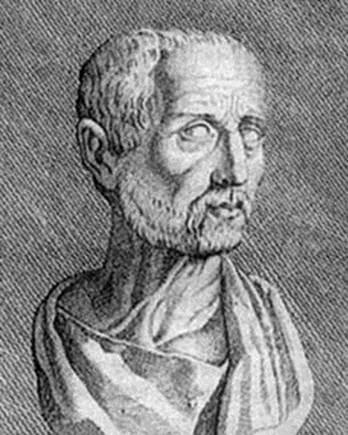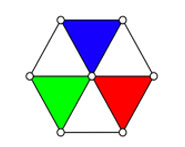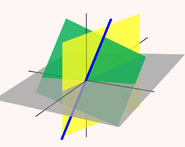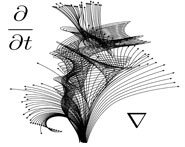


 تاريخ الرياضيات
تاريخ الرياضيات
 الرياضيات في الحضارات المختلفة
الرياضيات في الحضارات المختلفة 
 الرياضيات المتقطعة
الرياضيات المتقطعة
 الجبر
الجبر
 الهندسة
الهندسة 
 المعادلات التفاضلية و التكاملية
المعادلات التفاضلية و التكاملية 
 التحليل
التحليل
 علماء الرياضيات
علماء الرياضيات |
Read More
Date: 19-10-2015
Date: 19-10-2015
Date: 20-10-2015
|
Born: 135 BC in Apameia, near Shaizar, Syria
Died: 51 BC in Rhodes
 Posidonius of Rhodes is also known as Posidonius of Apameia. The first of these names refers to where he taught while the second refers to the town of his birth, Apameia on the Orontes. One must not think of these two as different people.
Posidonius of Rhodes is also known as Posidonius of Apameia. The first of these names refers to where he taught while the second refers to the town of his birth, Apameia on the Orontes. One must not think of these two as different people.
Although he was born in Apameia in Syria, Posidonius was from a Greek family and he was brought up in the Greek tradition. He went to Athens to complete his education, and there he studied under the Stoic philosopher Panaetius of Rhodes. Posidonius travelled widely in the western Mediterranean region and he made many scientific studies on his travels relating to astronomy, geography and geology.
Some time not long after 100 BC Posidonius became the head of the Stoic School in Rhodes. While in this position he also held political office in Rhodes. It was in a political position, as ambassador of Rhodes, that he travelled to Rome in 87-86 BC. There he met a number of men who he had known and taught earlier including Cicero.
In Rome Posidonius visited Gaius Marius, the Roman general and politician who was consul seven times. Marius died on 13 January 86 BC while Posidonius was still in Rome. While there Posidonius became friends with Pompey the Great who had been educated in the Greek tradition. Pompey the Great kept up his friendship with Posidonius and visited him in Rhodes on a number of later occasions when on his military campaigns.
None of the writing of Posidonius has survived but much has been written about his achievements and much work has been undertaken trying to reconstruct his views from the fragments of his writings which are preserved in quotations by later authors.
Posidonius made some minor contributions to pure mathematics where he is [2]:-
... quoted as the author of certain definitions, or for views on technical terms. e.g. 'theorem' and 'problem', and subjects belonging to elementary geometry.
... he wrote a separate work in refutation of the Epicurean Zeno of Sidon, who had objected to the very beginnings of the "Elements" on the ground that they contained unproved assumptions.
His work on astronomy is fairly well known to us through the treatise by Cleomedes On the Circular Motions of the Celestial Bodies. The work is in two volumes and as Heath comments [2]:-
... the very long first chapter of Book II (nearly half of the Book) ... seems for the most part to be copied bodily from Posidonius.
Cleomedes explains in his work the method used by Posidonius to calculate the length of the circumference of the earth. His method is based on observations of the star Canopus at Rhodes and Alexandria. At Rhodes he observes that Canopus touches the horizon while at Alexandria it reaches an altitude of 7° 30'. Using a distance of 5000 stadia between Rhodes and Alexandria this gave Posidonius a value of 240000 stadia for the circumference of the earth. This a very accurate value, but it is produced because of two compensating errors.
Both figures used by Posidonius in the above calculation are inaccurate. The 7° 30' should be really 5° 15' while the figure of 5000 stadia for the Rhodes to Alexandria distance is also incorrect. Later Ptolemy informs us via the writings of Cleomedes, Posidonius used the more accurate 3750 stadia for the Rhodes to Alexandria distance but kept his very inaccurate 7° 30' thus obtaining the figure of 180000 stadia for the circumference which is far too small. We should note, however, that Taisbak in [11] attempts to prove that attributing this far too small value of 180000 stadia to Posidonius is unfounded. Eratosthenes had given a much more accurate value of 252000 stadia 150 years before Posidonius.
Posidonius also made calculations of the size and distance to the moon, and the size and distance to the sun. His measurements of the moon are inaccurate partly because he assumes a cylindrical rather than conical shadow. As to his calculations of the sun, Neugebauer writes [3]:-
Posidonius's attempts (according to Cleomedes) to determine the size of the sun are rather naive and make it difficult to understand that his astronomy was not ridiculed by authors like Cicero and Pliny who pretend to know the work of Hipparchus.
As to Posidonius's views on knowledge he believed that [1]:-
... fundamental principles depended on philosophers and individual problems on scientists; and he believed that, among early men, the philosophically wise managed everything and discovered all crafts and industry. ... For true judgement the standard is right reasoning; but precepts, persuasion, consolation, and exhortation are necessary; and enquiry into causes as opposed to matter is important.
Posidonius wrote on meteorology, a topic where he closely followed the teachings of Aristotle. He gave theories to explain clouds, mist, wind and rain. He also gave opinions on frost, hail and rainbows. Lightning and earthquakes interested him and he tried to approach all these topics in a scientific manner although he had little chance of coming up with explanations which were anywhere close to being correct.
In moral philosophy he followed the Stoic teachings and gave opinions on virtue, evil, the soul, and emotions. He wrote historical works covering the period from about 146 BC to about 63 BC. These works give an account of the Roman civil wars and the contacts by the Greeks and the Romans with other peoples such as the Celts, Germans, and peoples of Spain and Gaul
Books:
Articles:



|
|
|
|
دخلت غرفة فنسيت ماذا تريد من داخلها.. خبير يفسر الحالة
|
|
|
|
|
|
|
ثورة طبية.. ابتكار أصغر جهاز لتنظيم ضربات القلب في العالم
|
|
|
|
|
|
|
قسم شؤون المعارف ووفد من جامعة البصرة يبحثان سبل تعزيز التعاون المشترك
|
|
|